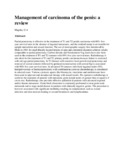| dc.contributor.author | Magoha, G A | |
| dc.date.accessioned | 2013-02-22T05:05:53Z | |
| dc.date.issued | 1995-09 | |
| dc.identifier.citation | East Afr Med J. 1995 Sep;72(9):547-50 | en |
| dc.identifier.uri | http://erepository.uonbi.ac.ke:8080/xmlui/handle/123456789/10662 | |
| dc.identifier.uri | http://www.ncbi.nlm.nih.gov/pubmed/7498037 | |
| dc.description.abstract | Partial penectomy is effective in the treatment of T1 and T2 penile carcinoma with 80% five-year survival rates in the absence of inguinal metastases, and the residual stump is serviceable for upright micturition and sexual function. The use of micrographic surgery first introduced by Mohs in 1941 for small distally located lesions of upto one centimetre diametre achieves results comparable to partial penectomy. Carbon dioxide and Neodymium-Yag lasers have also been used in the treatment of T1 and T2 tumours with 89% five year survival rates. Radiotherapy is also ideal for the treatment of T1 and T2 primary penile carcinoma because failure is corrected with salvage partial penectomy. In T3 disease with extensive local growth total penectomy and removal of scrotal contents followed by perineal reconstruction with scrotal flap is associated with 90% five year survival rates. In advanced T4 tumours with fixed inguinal nodes (N3), hemipelvectomy or hemicorporectomy with combination cytotoxic chemotherapy is considered in selected cases. Various cytotoxic agents like bleomycin, vincristine and methotrexate have been used in adjuvant and neoadjuvant therapy with mixed results. Pre operative radiotherapy is useful in the treatment of patients with metastatic groin lymph nodes of greater than or equal to 4 cm in size. Radiotherapy also provides effective palliation in patients with advanced regional and/or distant metastases. Groin block dissection is commonly performed to treat groin node metastasis and to stage nodal disease in patients with clinically negative groins. The procedure is however associated with significant morbidity resulting in complications such as wound infection and skin necrosis leading to wound breakdown and lymphoedema. | en |
| dc.subject | carcinoma | en |
| dc.subject | penis | en |
| dc.title | Management of carcinoma of the penis: a review | en |
| dc.type | Article | en |
| local.publisher | Department of Surgery, College of Health Sciences, University of Nairobi, Kenya | en |

